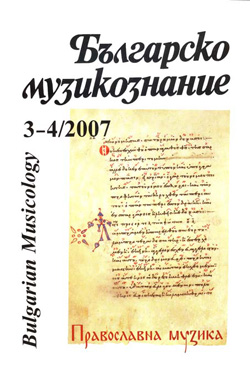„Болгарский роспев" („напел")
"Bolgarskij Rospev" ("Napel")
Author(s): Elena TonchevaSubject(s): Music
Published by: Институт за изследване на изкуствата, Българска академия на науките
Summary/Abstract: From the end of the 16th and throughout the 17th and 18th centuries, in Ukrainian and Belarusian manuscripts (and in Russian sources beginning in the middle of the 17th century), a large repertoire was notated using the Kievan quadratic staff notation; this repertoire was long associated with the ethnonym “Bulgarian,” i.e. Bolgarskij napel and Bolgarskij rospev - “Bulgarian chant”. This so-called “Bulgarian chant” became known in Bulgaria during the transition to the New Era (the end of the 19th and the beginning of the 20th centuries) with the introduction of Russian choral liturgical singing in Bulgaria. A public discussion arose about what authentic old Bulgarian liturgical singing was: Bolgarskij rospev or the traditional Balkan monophonic chant from the revival era (after the Chrysanthos Reform of 1814). The paper briefly traces the opinions of the most prominent Bulgarian composer of that time, Dobri Hristov (1875-1941), about “Bolgarskij rospev,” and also discusses the results of research on this type of chant in the context of Russian liturgical singing by Ivan Boznesenski (according to his 1891 publication). Both authors accept that this singing comes from Bulgaria, having been produced in the oral tradition and possessing very specific stylistic characteristics. Elena Toncheva’s important discovery is also noted: three Hiermologia with such repertoire from the Great Skit Monastery located near Manyava village in the Lvov Region in the eastern Carpathians, which was the center of what the Skit Hiermologia call “Old Bulgarian chant.” A short history of the monastery is presented, as well as an explanation of its connections with the Balkan region. Initial studies of the “Bolgarskij rospev” from Skit revealed a specific psalmodic style of an early kind: the construction of the entire composition through the periodic repetition of a melodic period with a psalmodic appearance, which supports I. Boznesenski’s conclusions. Thus, we arrived at the opinion that Bolgarskij rospev which we find in the Ukrainian liturgical chant tradition, originates from the Balkans, in particular from Bulgaria as early as the time of the acceptance of Christianity (9th century). It was passed on in the oral tradition (only with the use of the so-called short or melisma theta notation). With the establishment of the Revised Jerusalem liturgical order in bilingual Greek-Slavic sources from the 15th century, the transition from oral to written practice was begun. This process can be observed in bi-lingual musical manuscripts notated with late Byzantine notation, such as the so-called Rila Musical Marginal Notes, the Skopje Papadika manuscript (MS Belgrade 93), the Zegligovo Anthology (Athens manuscript № 928), and the manuscript family from the Putna Monastery in Moldova (16th century). The idea occurred to conduct comparative research between chants with parallel Slavic-language texts from the Balkan Greek Slavic late Byzantine notational sources on the...
Journal: Българско музикознание
- Issue Year: 2007
- Issue No: 3-4
- Page Range: 165-189
- Page Count: 25
- Language: Bulgarian
- Content File-PDF

